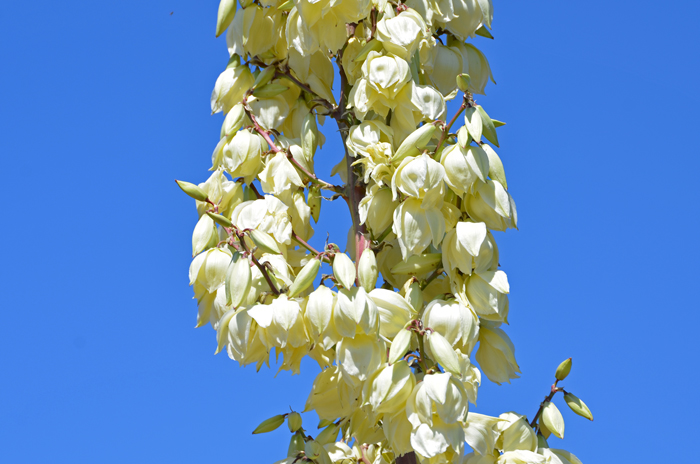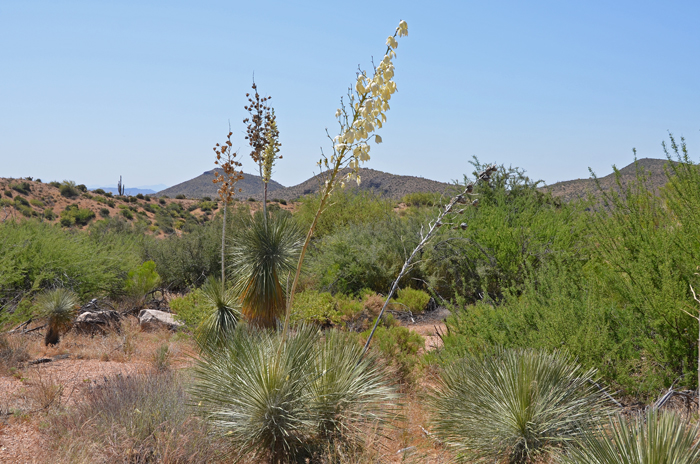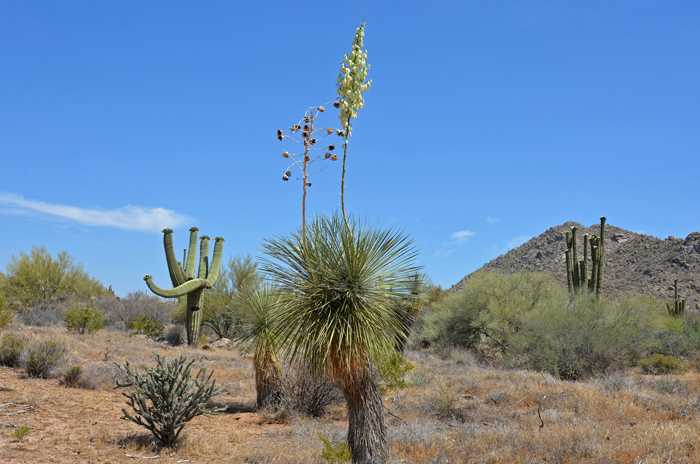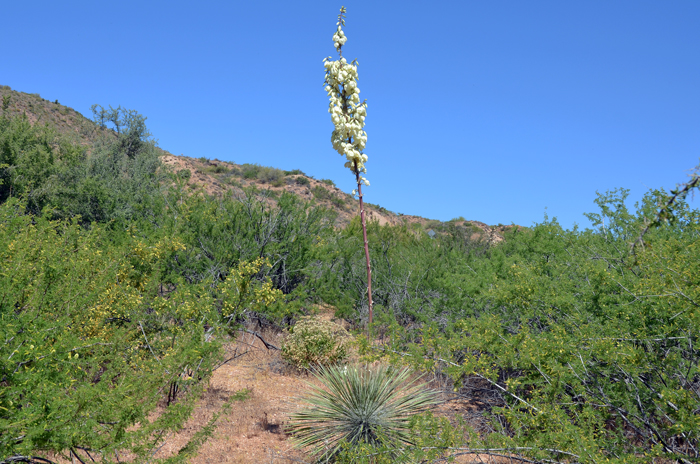Yucca elata, Soaptree Yucca




Scientific Name: Yucca elata
Common Name: Soaptree Yucca
Also Called: Amole, Palmella, Palmilla, Soap Tree Yucca, Soapweed, Soap-tree Yucca, Soap-weed Yucca (Spanish: Palmilla, Yuca, Sota, Cortadillo, Palmito, Soyate)
Family: Agavaceae, Agave or Century Plant Family (Reclassified to Asparagaceae)
Synonyms: (Yucca angustissima var. elata, Yucca elata var. elata, Yucca elata var. utahensis, Yucca elata var. verdiensis, Yucca utahensis, Yucca verdiensis)
Status: Native
Duration: Perennial.
Size: Up to 20 feet or more.
Growth Form: Shrub, tree; solitary or forming colonies of rosettes; single trunk or clustered trunks; caulescent; distinctly tree-like; stems erect; slow growth.
Leaves: Green, gray-green, blue-green, pale green; linear and widest near the middle; margins white, entire, curled, filiferous.
Flower Color: White, creamy-white or cream; flowers pendent; sepals and petal similar, called tepals; inflorescence up to 7 feet, 25 or more side branches with clusters of showy bell-shaped flowers, mostly paniculate; fruit an erect dry, brown, woody capsule.
Flowering Season: May to July; April to June in Texas.
Elevation: 1,000 to 6,000 feet.
Habitat Preferences: Grasslands, mesas, rocky hillsides, canyons and desert hillsides.
Recorded Range: Yucca elata is found in the southwest United States and northern Mexico. In the United States it is found in; AZ, NM, NV, TX, UT.
North America & US County Distribution Map for Yucca elata.
U.S. Weed Information: No information available.
Invasive/Noxious Weed Information: No information available.
Wetland Indicator: No information available.
Threatened/Endangered Information: In North America Yucca elata is listed as "Salvage Restricted" by the state of Arizona. In Nevada, Yucca elata var. utahensis is "Protected" as a Cactus, Yucca, or Christmas Tree.
In the Southwestern United States: Arizona has 8 species of Yucca, California has 3 species, Nevada has 5 species, New Mexico has 10 species, Texas has 18 species, Utah has 7 species. All data is approximate and subject to taxonomic changes.
There are 2 varieties in Yucca elata;
Yucca elata var. elata, Palmella, (AZ);
Yucca elata var. verdiensis, Palmella, (AZ, NM, TX).
Comments: Yucca elata is one of the most important resources for southwestern North American indigenous peoples. Similar to the Banana Yucca, almost all parts of the Soaptree Yucca are used including stalks, leaves, flowers, fruits and roots. The plant provides a food source and materials for development of a variety of items.
With large showy white flowers and handsome silhouette, Soaptree is used as landscape specimens in large desert or upland settings. The large size precludes use in smaller residential landscapes.
Yucca elata, although superficially similar in appearance to palm tree, and has common named Palmella and Palmilla, is not a palm or in the palm family but placed within the Agave family, and now Asparagaceae. The lectotype species is from Camp Grant, Graham County (Rothrock 382).
In Southwestern Desert Flora also see: Banana Yucca, Yucca baccata; Blue Yucca, Yucca rigida; Beaked Yucca, Yucca rostrata; Eve's Needle, Yucca faxoniana; Joshua Tree and Yucca brevifolia.
Yucca elata has been used for a variety of purposes by South American indigenous peoples.
Apache Food, Vegetable; Flowers boiled and eaten as a vegetable.
Apache, Chiricahua & Mescalero Fiber, Basketry; Leaves woven into shallow or tray baskets to carry prepared mescal home.
Apache, Western Drug, Ceremonial Medicine; Peeled stalk shaped like a short snake, heated, eaten by a practitioner and spit at the sick.
Apache, Western Food, Dried Food; Boiled blossoms dried and stored in a dry place.
Apache, Western Food, Unspecified; Stalk charred and eaten like sugar cane.
Navajo Other, Ceremonial Items; Leaves made into scourges and used in the Night Chant. A leaf was taken from the east side of the plant and one from the west. The leaves were then split in two and the interchanged halves bound together to form the scourge. These scourges were carried by the different person in the Night Chant.
Navajo Other, Toys & Games; Used to make the 102 counting sticks for the moccasin game.
Papago Fiber, Building Material; Used for the weft of wrapped weaving in house frames.
Pima Other, Containers; Cactus ribs bound together to form the frame for containers used to carry crops.
Pima Other, Soap; Used as soap.
Southwest Indians Food, Dried Food; Stems baked, dried, softened in water and eaten.
See ethno-botanical uses at Native American Ethnobotany, University of Michigan, Dearborn.

